Sandy Reef Slopes of the Red Sea:
These are regions of tapering slope that
immediately follow the base of the reef slopes that make up the vast
majority of the coasts and island borders of the Red Sea, generally
abruptly sloping at the end of the rocky reef slope by a few tens of
degrees. They're characterized by a mix of sandy patches of mainly
mixed fine (1 mm.) and coarser carbonaceous materials randomly broken
up with rock and coral bommies of varying size, most not more than a
foot or two in elevation. In the few rare areas where sandy beaches
occur, the flora and fauna can be strikingly different (e.g.
seagrasses) than these post-shore slopes.
Most sandy reef slope areas gently (ten percent
or less) grade into an area of more rapid drop-offs within a hundred
feet or so of width. Being in depths principally of ten to thirty
meters in depth, these sandy reef slopes receive a few to one percent
of incidental insolation (sunlight). Currents can be slack to one, two
knot/h, though not as pronounced at the reef/water interface.
About Sandy Red Sea Reef Slopes: Make-Up, Features
of Aquarium Importance
Lower light and water movement conditions
work fine for displays incorporating these biotopes. A mix of calcium
carbonate substrate sizes is preferable, particularly when
incorporating burrowing, sand-dwelling life.
| Images of Red Sea Reef Slopes showing
characteristic traits. An image showing the Reef Flat, over the
edge to the vertical Rocky Reef Slope and the sudden grade to the
Sandy Reef Slope. A typical bottom on the Sandy Reef Slope at
right, with the ubiquitous Pulsing Coral and a bit of
Acropora. |
| Video of Sandy Red Sea Reef Slopes: to
be done: place link to video at right, instructions to right click
icons. |
|
Biota of the Sandy Reef Slopes of the
Red Sea:
Here we will list and describe the species of
most use and availability to aquarists. Of course there are many more
species than can be practically detailed here and some species that
should not be offered to the hobby do make their way into markets. As a
precautionary measure we'll include a table of ones that are often
for sale, but shouldn't be due to historically dismal survival
records.
|
Most Common Species of Sandy Red Sea Reef
Slopes
|
| Seagrasses. For the true aficionado and aquarist
looking for a challenge, two species of seagrasses occur here
in shallow, sandy areas. Of macrophyte algae Sargassum and
Turbinaria (Shown) are commonly found, with some scattered
Reds and Greens occurring in occasional mainly fist-size or smaller
clumps. |
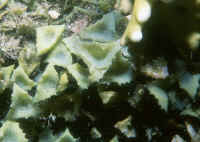 |
| Xeniids, Pulsing Corals, and how! These are the
dominant element of the landscape, almost covering any available
hard surface not otherwise colonized. |
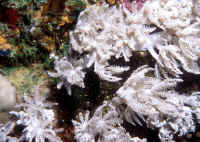 |
| Acroporids (Staghorn Corals), family Acroporidae.
Dominate what little hard, true coral populations exist here on
rocky patch reef areas or seemingly arise on their own pedestals as
with acroporids termed Table Corals. |
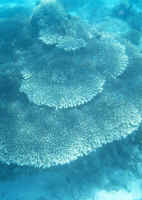 |
| Fire Coral, Millepora spp. Here, more
crustose varieties show up, along with large interbranching, planar
colonies. Deeper (30 meter) image showing the equally dominant
Xeniid species fighting for space with Millepora. |
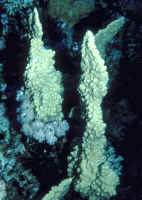 |
| Giant Clams, Tridacna maxima,
T. squamosa and T. crocea occur here in this order of
preponderance, and shown below. Do select only tank bred and reared
specimens. These are hardier, more disease free, and save making
"empty spaces" in the wild. |
| Gobies of various sorts; Shrimp Gobies of the
genera Amblyeleotris, Cryptocentrus, Istigobius and
Vanderhorstia and their mutualistic Alpheid (Pistol) Shrimp
partners are abundant, as are Amblygobius and
Valenciennea Sand Sifters and sand dwelling
Gnatholepis. For the very sharp-eyed, there are Gobiodon
gobies setting in and under Acropora table corals and teeny-tiny
Eviota (E. sebreei at right), Trimma and host
gobies of the genera Bryaninops and Pleurosicya. The
only goby from the area regularly offered in our interest is
Amblygobius hectori. |
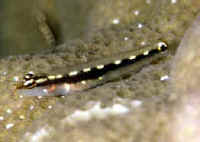 |
| Lionfishes, family Scorpaenidae. Look around and
under nooks and crannies and on every dive you will find at
least Pterois volitans (mainly black ones occur here). In
shallower, more calm settings it's not unusual to see several
Dendrochirus brachypterus perched on rocks, the sand or in
seagrass beds. |
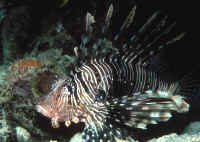 |
| Angelfishes, family Pomacanthidae. The Swallowtail,
Genicanthus caudovittatus is quite abundant in places, as is
the dwarf, Centropyge multispinus (though often unnoticed
hiding). The occasional larger Red Sea Angel species do cruise by
(see coverage below). |
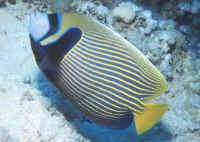 |
| Goatfishes, family Mullidae. Two of the twenty
three species found in the Red Sea stick out for beauty and utility
(as sand stirrers), and general availability: Mulloides
vanicolensis and Parupeneus cyclostomus (male shown at
right). |
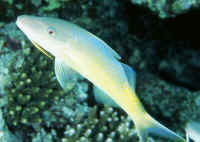 |
| Wrasses, family Labridae. The Red Sea is FULL of
"Lippsfische"; some sixty nine species are found here,
mainly associated with the sandy reef slope. Some are huge,
others too boisterous for aquarium use, others are "just
right". |
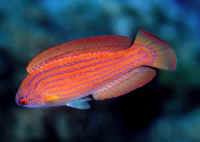 |
| Lizardfishes, family Synodontidae. Ten species
occur in the Red Sea, some almost always in view on/near the sandy
bottom, perched there or on a rocky area observing their world.
Though rarely offered in the trade (they're not beautifully
colored), these stealthy predators are ubiquitous on sandy shallows
in the Red Sea (as well as most everywhere in the tropical
Indo-Pacific). If you can find one of the more common species, give
it a try, but not with small fishes that will become meals. |
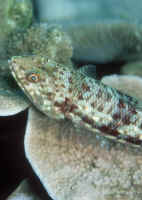 |
On to: Sandy Red Sea Reef Slope 2 of
5

